Use of the Gene-Expression Programming Equation and FEM for the High-Strength CFST Columns
Abstract
1. Introduction
2. A Brief Background of Gene Expression Programming (GEP) and Finite Element Analysis (FEA)
3. Prediction of Bearing Capacity of Concrete-Filled Steel Tube (CFST) Columns by Finite Element Analysis (FEA)
3.1. Brief Introduction
3.2. FE Modelling and Analysis
3.3. The Results of FE Simulation
4. Results, Comparison, and Discussion of the GEP Equation Outcomes with the FEA Results
5. Concluding Remarks
- A very good agreement is evident between the experimental outcomes and the GEP equation results with a less than 14% difference of the estimated bearing capacity for the majority of the cases;
- More than 85% of the results from Equation (1) were in accordance with the experimental results which proves the suitability and workability of this GEP-based equation for the prediction of the ultimate bearing capacity of the CFST columns;
- Only five models showed considerable differences in predicted values by GEP compared to the experimental data which could be because of the specific conditions of the composite columns such as low L/D ratio, slenderness rate, use of very high or very low strength for materials and the application of heavy loads to the columns.
Author Contributions
Funding
Acknowledgments
Conflicts of Interest
Appendix A
| No. | Ref. No | D (mm) | L (mm) | t (mm) | L/D | D/t | fy (MPa) | Es (GPa) | f’c (MPa) | Ec (GPa) | υ |
|---|---|---|---|---|---|---|---|---|---|---|---|
| 1 | [25] | 114.3 | 210 | 6.3 | 1.84 | 18.14 | 428 | 209 | 173.5 | 63 | 0.3 |
| 2 | [25] | 114.3 | 250 | 3.6 | 2.19 | 31.75 | 403 | 213 | 184.2 | 63 | 0.3 |
| 3 | [25] | 219.1 | 600 | 5 | 2.74 | 43.82 | 380 | 205 | 185.1 | 66 | 0.3 |
| 4 | [25] | 219.1 | 600 | 10 | 2.74 | 21.91 | 381 | 212 | 185.1 | 66 | 0.3 |
| 5 | [25] | 219.1 | 600 | 10 | 2.74 | 21.91 | 381 | 212 | 193.3 | 67 | 0.3 |
| 6 | [25] | 219.1 | 600 | 6.3 | 2.74 | 34.78 | 300 | 202 | 163 | 62 | 0.3 |
| 7 | [25] | 219.1 | 600 | 6.3 | 2.74 | 34.78 | 300 | 202 | 175.4 | 58 | 0.3 |
| 8 | [25] | 219.1 | 600 | 6.3 | 2.74 | 34.78 | 300 | 202 | 148.8 | 54 | 0.3 |
| 9 | [25] | 219.1 | 600 | 6.3 | 2.74 | 34.78 | 300 | 202 | 174.5 | 56 | 0.3 |
| 10 | [6] | 168.6 | 645 | 3.9 | 3.83 | 43.23 | 363 | 206 | 36.2 | 33 | 0.3 |
| 11 | [6] | 168.6 | 645 | 3.9 | 3.83 | 43.23 | 363 | 206 | 95.8 | 33 | 0.3 |
| 12 | [6] | 164.2 | 652 | 2.5 | 3.97 | 65.68 | 377 | 206 | 158.46 | 33 | 0.3 |
| 13 | [6] | 189 | 756 | 3 | 4.00 | 63.00 | 398 | 206 | 158.46 | 33 | 0.3 |
| 14 | [6] | 168.6 | 648 | 3.9 | 3.84 | 43.23 | 363 | 206 | 165.49 | 33 | 0.3 |
| 15 | [6] | 169 | 645 | 4.8 | 3.82 | 35.21 | 399 | 206 | 167.87 | 33 | 0.3 |
| 16 | [6] | 168.7 | 645 | 5.2 | 3.82 | 32.44 | 405 | 206 | 158.75 | 33 | 0.3 |
| 17 | [6] | 168.8 | 650 | 5.7 | 3.85 | 29.61 | 452 | 206 | 151.91 | 33 | 0.3 |
| 18 | [6] | 168.1 | 645 | 8.1 | 3.84 | 20.75 | 409 | 206 | 158.75 | 33 | 0.3 |
| 19 | [6] | 165 | 500 | 2.81 | 3.03 | 58.72 | 350 | 212 | 67.94 | 67 | 0.3 |
| 20 | [6] | 165 | 500 | 2.76 | 3.03 | 59.78 | 350 | 212 | 67.94 | 67 | 0.3 |
| 21 | [6] | 114.3 | 342.9 | 3.35 | 3.00 | 34.12 | 287.33 | 212 | 86.21 | 67 | 0.3 |
| 22 | [6] | 114.3 | 342.9 | 6 | 3.00 | 19.05 | 342.95 | 212 | 56.99 | 67 | 0.3 |
| 23 | [6] | 114.3 | 342.9 | 6 | 3.00 | 19.05 | 342.95 | 212 | 86.21 | 67 | 0.3 |
| 24 | [6] | 114.3 | 342.9 | 6 | 3.00 | 19.05 | 342.95 | 212 | 102.43 | 67 | 0.3 |
| 25 | [6] | 114.3 | 200 | 6.3 | 1.75 | 18.14 | 428 | 212 | 164.35 | 67 | 0.3 |
| 26 | [7] | 200 | 600 | 1.945 | 3.00 | 102.83 | 227 | 212 | 52.7 | 67 | 0.3 |
| 27 | [7] | 200 | 600 | 1.945 | 3.00 | 102.83 | 227 | 212 | 67.7 | 67 | 0.3 |
| 28 | [7] | 200 | 600 | 1.945 | 3.00 | 102.83 | 227 | 205 | 74.4 | 58 | 0.3 |
| 29 | [7] | 260 | 780 | 1.945 | 3.00 | 133.68 | 227 | 205 | 52.7 | 58 | 0.3 |
| 30 | [7] | 260 | 780 | 1.945 | 3.00 | 133.68 | 227 | 205 | 85.4 | 58 | 0.3 |
| 31 | [14] | 299 | 848 | 1.68 | 2.84 | 177.98 | 267.5 | 205 | 47.2 | 58 | 0.3 |
| 32 | [26] | 273 | 4195 | 10 | 15.37 | 27.30 | 412 | 205 | 180 | 58 | 0.3 |
References
- Sarir, P.; Shen, S.L.; Wang, Z.F.; Chen, J.; Horpibulsuk, S.; Pham, B.T. Optimum model for bearing capacity of concrete-steel columns with AI technology via incorporating the algorithms of IWO and ABC. Eng. Comput. 2021, 37, 797–807. [Google Scholar] [CrossRef]
- Han, L.H.; An, Y.-F. Performance of concrete-encased CFST stub columns under axial compression. J. Constr. Steel Res. 2014, 93, 62–76. [Google Scholar] [CrossRef]
- Han, L.H.; Li, W.; Bjorhovde, R. Developments and advanced applications of concrete-filled steel tubular (CFST) structures: Members. J. Constr. Steel Res. 2014, 100, 211–228. [Google Scholar] [CrossRef]
- Tao, Z.; Wang, Z.B.; Yu, Q. Finite element modelling of concrete-filled steel stub columns under axial compression. J. Constr. Steel Res. 2013, 89, 121–131. [Google Scholar] [CrossRef]
- Keshavarz, A.; Mehramiri, M. New gene expression programming models for normalized shear modulus and damping ratio of sands. Eng. Appl. Artif. Intell. 2015, 45, 464–472. [Google Scholar] [CrossRef]
- Khandelwal, M.; Faradonbeh, R.S.; Monjezi, M.; Armaghani, D.J.; Majid, M.Z.A.; Yagiz, S. Function development for appraising brittleness of intact rocks using genetic programming and non-linear multiple regression models. Eng. Comput. 2017, 33, 13–21. [Google Scholar] [CrossRef]
- Koopialipoor, M.; Armaghani, D.J.; Haghighi, M.; Ghaleini, E.N. A neuro-genetic predictive model to approximate overbreak induced by drilling and blasting operation in tunnels. Bull. Eng. Geol. Environ. 2019, 78, 981–990. [Google Scholar] [CrossRef]
- Uddin, M.N.; Li, L.Z.; Khan, R.K.M.; Shahriar, F.; Sob, L.W.T. Axial capacity prediction of concrete-filled steel tubular short members using multiple linear regression and artificial neural network. Mater. Sci. Forum 2021, 1047, 220–226. [Google Scholar] [CrossRef]
- Chen, W.; Sarir, P.; Bui, X.N.; Nguyen, H.; Tahir, M.M.; Armaghani, D.J. Neuro-genetic, Neuro-imperialism and genetic programing models in predicting ultimate bearing capacity of pile. Eng. Comput. 2020, 36, 1101–1115. [Google Scholar] [CrossRef]
- Sarir, P.; Chen, J.; Asteris, P.G.; Armaghani, D.J.; Tahir, M.M. Developing GEP tree-based, Neuro-swarm, and whale optimization models for evaluation of bearing capacity of concrete-filled steel tube columns. Eng. Comput. 2021, 37, 1–19. [Google Scholar] [CrossRef]
- Javadi, A.; Mehravar, M.; Faramarzi, A.; Ahangar-Asr, A. An artificial intelligence based finite element method. ISAST Trans. Comput. Intell. Syst. 2009, 6, 11–17. [Google Scholar]
- Alani, Y.R.A.; Agarwal, V. Nonlinear finite element study on the circular concrete filled steel tubular columns. Int. J. Innov. Technol. Explor. Eng. 2013, 3, 52–55. [Google Scholar]
- Armaghani, D.J.; Hajihassani, M.; Bejarbaneh, B.Y.; Marto, A.; Mohamad, E.T. Indirect measure of shale shear strength parameters by means of rock index tests through an optimized artificial neural network. Meas. J. 2014, 55, 487–498. [Google Scholar] [CrossRef]
- Armaghani, D.J.; Safari, V.; Fahimifar, A.; Amin, M.F.M.; Monjezi, M.; Mohammadi, M.A. Uniaxial compressive strength prediction through a new technique based on gene expression programming. Neural Comput. Appl. 2018, 30, 3523–3532. [Google Scholar] [CrossRef]
- Elshekh, E.; Shafiq, N.; Nuruddin, I.; Fathi, A. High strength concrete. J. Appl. Sci. 2014, 14, 1073–1077. [Google Scholar] [CrossRef]
- Evirgen, B.; Tuncan, A.; Taskin, K. Structural behavior of concrete filled steel tubular sections (CFT/CFSt) under axial compression. Thin-Walled Struct. 2014, 80, 46–56. [Google Scholar] [CrossRef]
- Faradonbeh, R.S.; Armaghani, D.J.; Monjezi, M. Development of a new model for predicting flyrock distance in quarry blasting: A genetic programming technique. Bull. Eng. Geol. Environ. 2016, 75, 993–1006. [Google Scholar] [CrossRef]
- Faradonbeh, R.S.; Armaghani, D.J.; Monjezi, M.; Mohamad, E.T. Genetic programming and gene expression programming for flyrock assessment due to mine blasting. Int. J. Rock Mech. Min. Sci. 2016, 88, 254–264. [Google Scholar] [CrossRef]
- Faradonbeh, R.S.; Hasanipanah, M.; Amnieh, H.B.; Armaghani, D.J.; Monjezi, M. Development of GP and GEP models to estimate an environmental issue induced by blasting operation. Environ. Monit. Assess. 2018, 190, 351–363. [Google Scholar] [CrossRef] [PubMed]
- Gordan, B.; Armaghani, D.J.; Hajihassani, M.; Monjezi, M. Prediction of seismic slope stability through combination of particle swarm optimization and neural network. Eng. Comput. 2016, 32, 85–97. [Google Scholar] [CrossRef]
- Gordan, B.; Koopialipoor, M.; Clementking, A.; Tootoonchi, H.; Mohamad, E.T. Estimating and optimizing safety factors of retaining wall through neural network and bee colony techniques. Eng. Comput. 2019, 35, 945–954. [Google Scholar] [CrossRef]
- Güneyisi, E.M.; Gültekin, A.; Mermerdaş, K. Ultimate capacity prediction of axially loaded CFST short columns. International J. Steel Struct. 2016, 16, 99–114. [Google Scholar] [CrossRef]
- Hoang, A.L.; Fehling, E.; Thai, D.; Van Nguyen, C. Evaluation of axial strength in circular STCC columns using UHPC and UHPFRC. J. Constr. Steel Res. 2019, 153, 533–549. [Google Scholar] [CrossRef]
- Khandelwal, M.; Armaghani, D.J.; Faradonbeh, R.S.; Ranjith, P.G.; Ghoraba, S. A new model based on gene expression programming to estimate air flow in a single rock joint. Environ. Earth Sci. 2016, 75, 739–745. [Google Scholar] [CrossRef]
- Koopialipoor, M.; Armaghani, D.J.; Hedayat, A.; Marto, A.; Gordan, B. Applying various hybrid intelligent systems to evaluate and predict slope stability under static and dynamic conditions. Soft Comput. 2018, 23, 5913–5929. [Google Scholar] [CrossRef]
- Koopialipoor, M.; Noorbakhsh, A.; Ghaleini, E.N. A new approach for estimation of rock brittleness based on non-destructive tests. Nondestruct. Test. Eval. 2019, 16, 214–223. [Google Scholar] [CrossRef]
- Koopialipoor, M.; Fallah, A.; Armaghani, D.J.; Azizi, A.; Mohamad, E.T. Three hybrid intelligent models in estimating flyrock distance resulting from blasting. Eng. Comput. 2019, 35, 243–256. [Google Scholar] [CrossRef]
- Koopialipoor, M.; Ghaleini, E.N.; Haghighi, M.; Kanagarajan, S.; Maarefvand, P.; Mohamad, E.T. Overbreak prediction and optimization in tunnel using neural network and bee colony techniques. Eng. Comput. 2018, 5, 4–12. [Google Scholar] [CrossRef]
- Koopialipoor, M.; Ghaleini, E.N.; Tootoonchi, H.; Armaghani, D.J.; Haghighi, M.; Hedayat, A. Developing a new intelligent technique to predict overbreak in tunnels using an artificial bee colony-based ANN. Environ. Earth Sci. 2019, 78, 165–178. [Google Scholar] [CrossRef]
- Kvočák, V.; Varga, G.; Vargová, R. Composite steel concrete filled tubes. Procedia Eng. 2012, 40, 469–474. [Google Scholar] [CrossRef][Green Version]
- Rabbat, B.G.; Russell, H.G. Friction coefficient of steel on concrete or grout. J. Struct. Eng. 1985, 111, 505–515. [Google Scholar] [CrossRef]
- Shen, S.L.; Wang, Z.F.; Sun, W.J.; Wang, L.B.; Horpibulsuk, S. A field trial of horizontal jet grouting using the composite-pipe method in the soft deposits of Shanghai. Tunn. Undergr. Space Technol. 2013, 35, 142–151. [Google Scholar] [CrossRef]
- Ahmadi, M.; Naderpour, H.; Kheyroddin, A. Utilization of artificial neural networks to prediction of the capacity of CCFT short columns subject to short term axial load. Arch. Civ. Mech. Eng. 2014, 14, 510–517. [Google Scholar] [CrossRef]
- Ren, Q.; Li, M.; Zhang, M.; Shen, Y.; Si, W. Prediction of ultimate axial capacity of square concrete-filled steel tubular short columns using a hybrid intelligent algorithm. J. Appl. Sci. 2019, 28, 2802. [Google Scholar] [CrossRef]
- Le, L.M.; Ly, H.B.; Pham, B.T.; Le, V.M.; Pham, T.A.; Nguyen, D.H.; Tran, X.T.; Le, T.T. Hybrid artificial intelligence approaches for prediction buckling damage of steel columns under axial compression. J. Mater. 2019, 16, 12–30. [Google Scholar]
- Cascardi, A.; Mircelli, F.; Aiello, M.A. An artificial neural networks model for the prediction of the compressive strength of FRP-confined concrete circular columns. J. Eng. Struct. 2017, 140, 199–208. [Google Scholar] [CrossRef]
- Lim, J.C.; Karakus, M.; Ozbakkaloglu, T. Evaluation of ultimate conditions of FRP-confined concrete columns using genetic programming. J. Comput. Struct. 2016, 162, 28–37. [Google Scholar] [CrossRef]
- Ahmadi, M.; Naderpour, H.; Kheyroddin, A. ANN model for predicting the compressive strength of circular steel-confined concrete. Int. J. Civ. Eng. 2017, 15, 213–221. [Google Scholar] [CrossRef]
- Güneyisi, E.M.; Abdikarim, I.N. Axial compression capacity of circular CFST columns transversely strengthened by FRP. Eng. Struct. 2019, 191, 417–431. [Google Scholar] [CrossRef]
- Jayalekshmi, S.; Jegadesh, J.S.S.; Goel, A. Empirical approach for determining axial strength of circular concrete filled steel tubular columns. J. Inst. Eng. 2018, 99, 257–268. [Google Scholar] [CrossRef]
- Ansari, Y.; Hashemi, A.H. Neural Network Approach in Assessment of Fiber Concrete Impact Strength. J. Civ. Eng. Mater. Appl. 2017, 1, 88–97. [Google Scholar] [CrossRef]
- Yagoubi, M.H. Prediction of ultimate strength for concrete-filled steel tube columns using artificial neural network. Ph.D. Thesis, University of Zabol, Zabol, Iran, 2018. [Google Scholar]
- Wang, Z.B.; Liu, L.Y. Finite element modelling of concrete-filled steel tube reinforced concrete stub columns under axial compression. Appl. Mech. Mater. 2013, 142, 351–359. [Google Scholar] [CrossRef]
- Xiao, J.; Huang, Y.; Yang, J.; Zhang, C. Mechanical properties of confined recycled aggregate concrete under axial compression. Constr. Build. Mater. 2012, 26, 591–603. [Google Scholar] [CrossRef]
- Kanishchev, R.; Kvocak, V. Stability and carrying capacity of the steel tubes. Procedia Eng. 2017, 190, 447–451. [Google Scholar] [CrossRef]
- Singh, H.; Gupta, P. Numerical modeling of rectangular concrete-filled steel tubular short columns. Contrib. Pap. 2013, 167–179. [Google Scholar]
- Davoudi, S.A.M.; Naghipour, M. Studying the Buckling Behavior of Composite Columns (CFST) by Cyclic Loading. J. Civ. Eng. Mater. Appl. 2019, 3, 203–213. [Google Scholar] [CrossRef]
- David, H. ABAQUS Standard User’s Manual, version 6.12.1, USA, 2012.
- Sarir, P.; Shen, S.-L.; Arulrajah, A.; Horpibulsuk, S. Concrete wedge and coarse sand coating shear connection system in GFRP concrete composite deck. Constr. Build. Mater. 2016, 114, 650–655. [Google Scholar] [CrossRef]
- Ding, H.T.; Francis, A.; Kaczmarek, O.; Karsch, F.; Laermann, E.; Soeldner, W. Thermal dilepton rate and electrical conductivity: An analysis of vector current correlation functions in quenched lattice QCD. Phys. Rev. D 2011, 83, 34–50. [Google Scholar] [CrossRef]
- Liang, Q.Q.; Fragomeni, S. Nonlinear analysis of circular concrete-filled steel tubular short columns under axial loading. J. Constr. Steel Res. 2009, 65, 2186–2196. [Google Scholar] [CrossRef]
- Hoang, A.L.; Fehling, E. Numerical study of circular steel tube confined concrete (STCC) stub columns. J. Constr. Steel Res. 2017, 136, 238–255. [Google Scholar] [CrossRef]
- Liu, J.; Teng, Y.; Zhang, Y.; Wang, X.; Chen, Y.F. Axial stress—Strain behavior of high-strength concrete confined by circular thin-walled steel tubes. Constr. Build. Mater. 2018, 177, 366–377. [Google Scholar] [CrossRef]
- Xiong, M.; Xiong, D.; Liew, J.Y.R. Axial performance of short concrete filled steel tubes with high- and ultra-high- strength materials. Eng. Struct. 2017, 136, 494–510. [Google Scholar] [CrossRef]
- Xiong, M.; Xiong, D.; Liew, J.Y.R. Behaviour of steel tubular members infilled with ultra-high strength concrete. J. Constr. Steel Res. 2017, 138, 168–183. [Google Scholar] [CrossRef]
- Wang, Y.; Yang, L.; Yang, H.; Liu, C. Behaviour of concrete- filled corrugated steel tubes under axial compression. Eng. Struct. 2019, 183, 475–495. [Google Scholar] [CrossRef]
- Stoffel, M.; Bamer, F.; Markert, B. Artificial neural networks and intelligent finite elements in non-linear structural mechanics. Thin-Walled Struct. 2018, 131, 102–106. [Google Scholar] [CrossRef]
- Dai, X.H.; Lam, D.; Jamaluddin, N.; Ye, J. Numerical analysis of slender elliptical concrete filled columns under axial compression. Thin-Walled Struct. 2014, 77, 26–35. [Google Scholar] [CrossRef]
- Roure, F.; Pastor, M.M.; Casafont, M.; Somalo, M.R. Stub column tests for racking design: Experimental testing, FE analysis and EC3. Thin-Walled Struct. 2011, 49, 167–184. [Google Scholar] [CrossRef]
- Code, P. Eurocode 4: Design of Structures for Earthquake Resistance-Part 1: General Rules, Seismic Actions and Rules for Buildings; European Committee for Standardization: Brussels, Belgium, 2005. [Google Scholar]
- Giakoumelis, G.; Lam, D. Axial capacity of circular concrete-filled tube columns. J. Constr. Steel Res. 2004, 60, 1049–1068. [Google Scholar] [CrossRef]
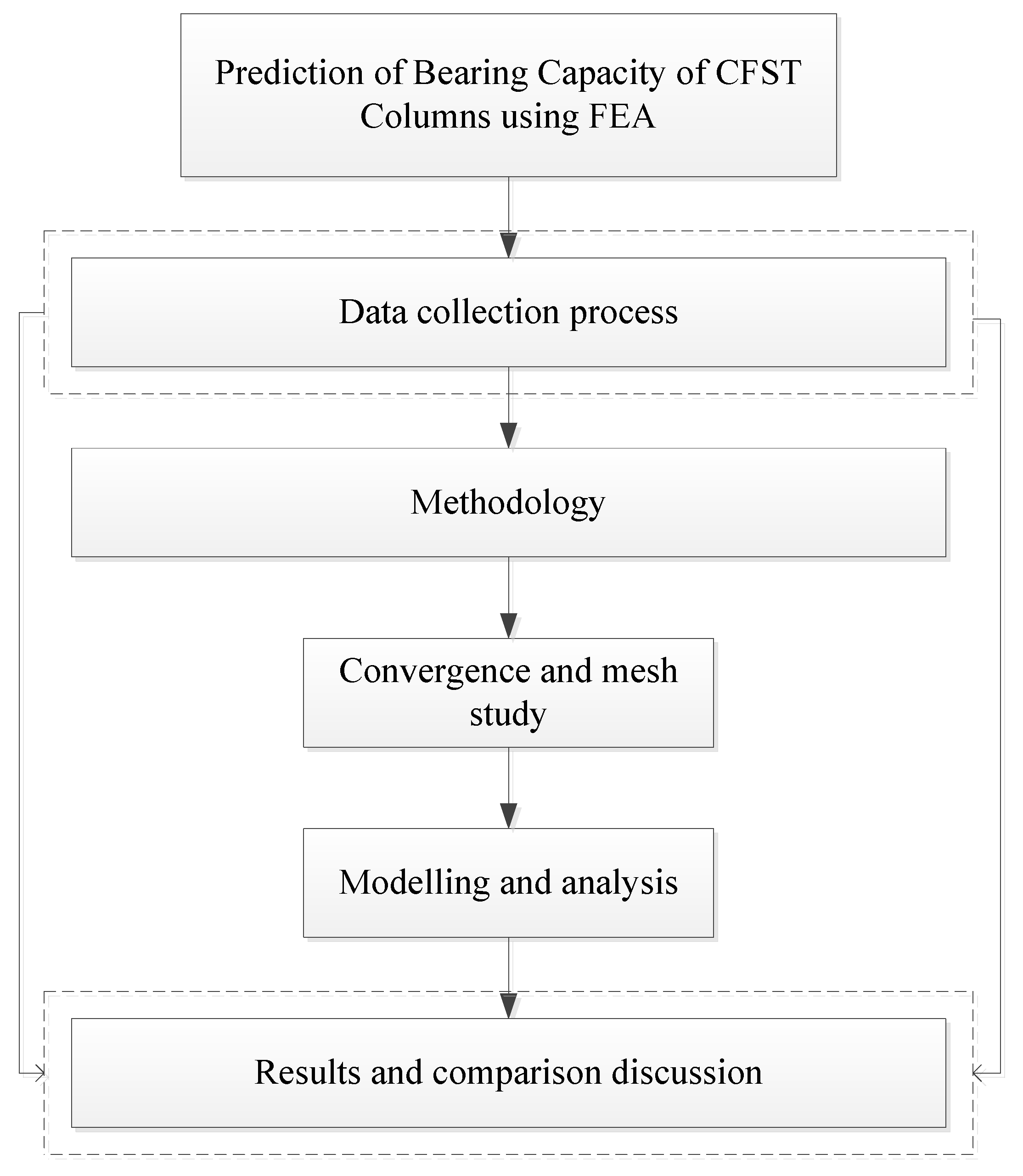
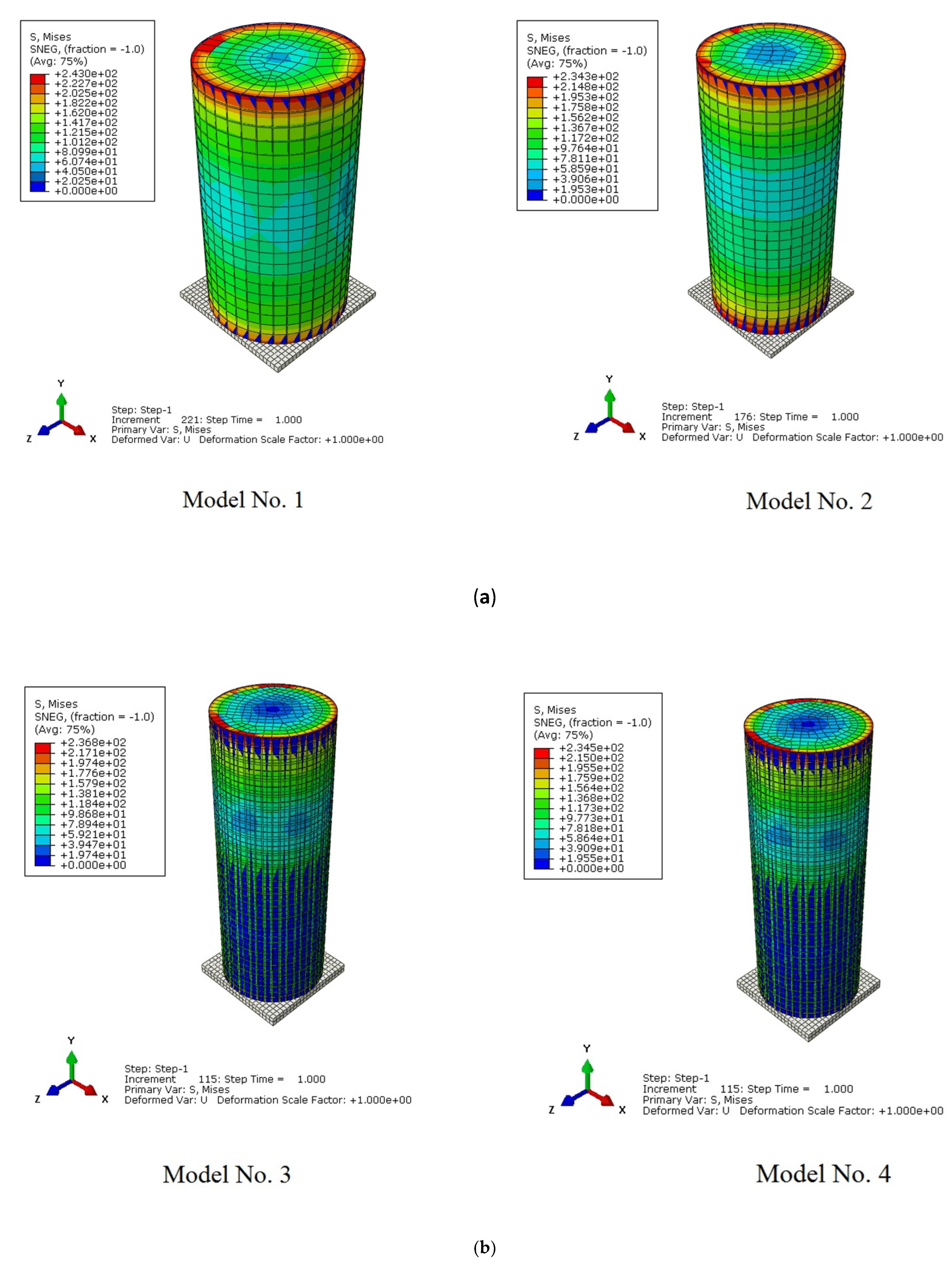
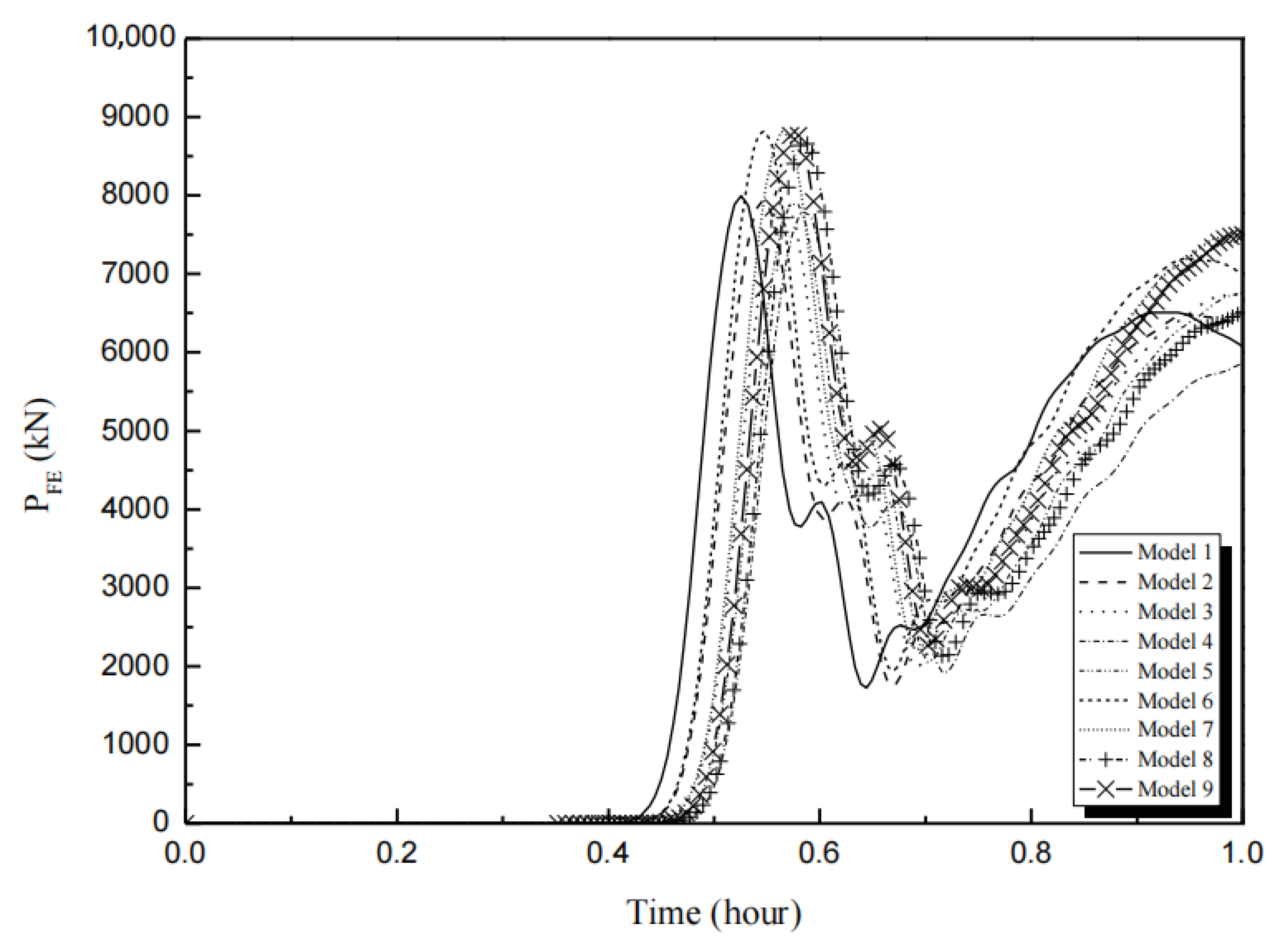
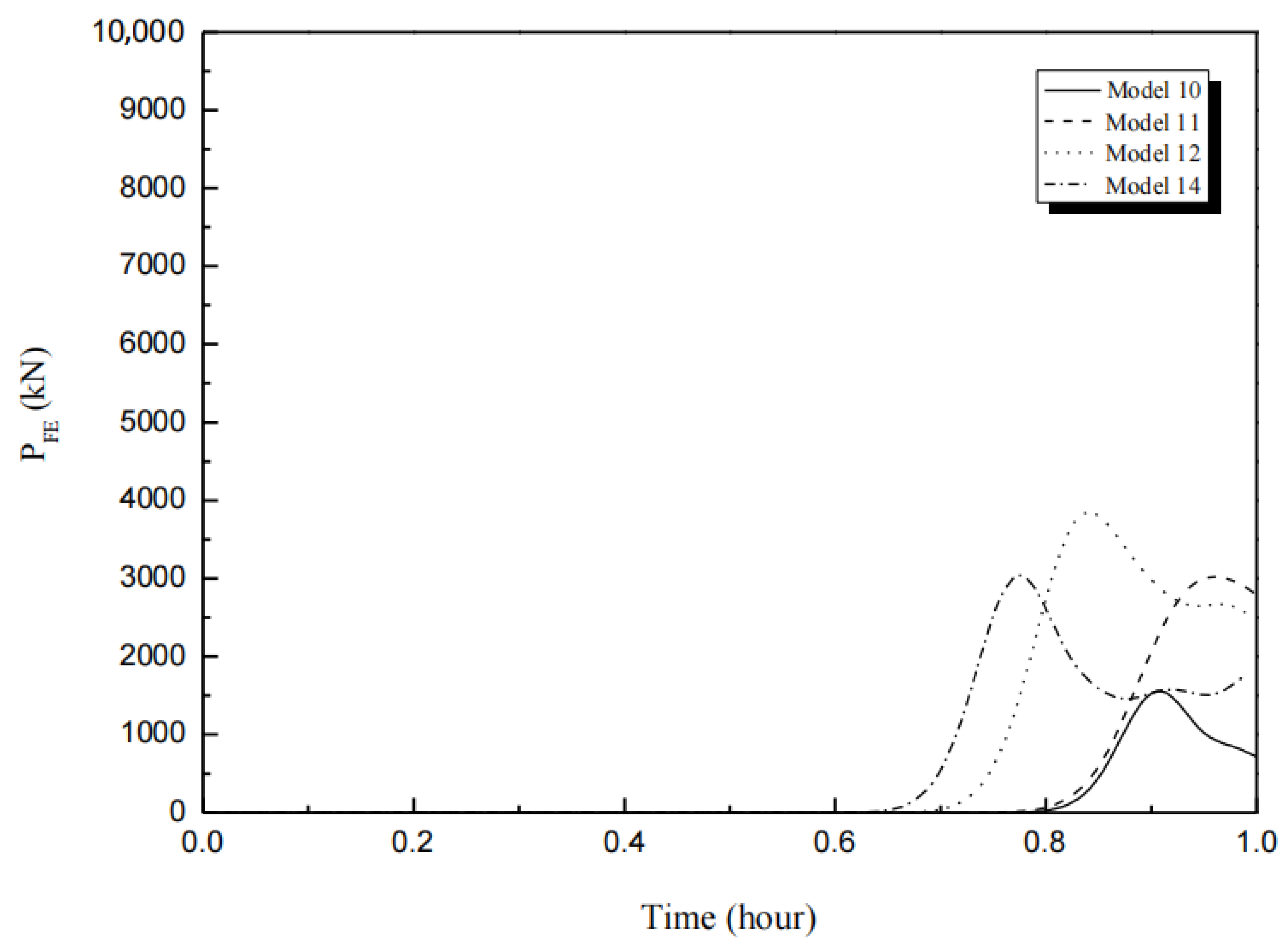
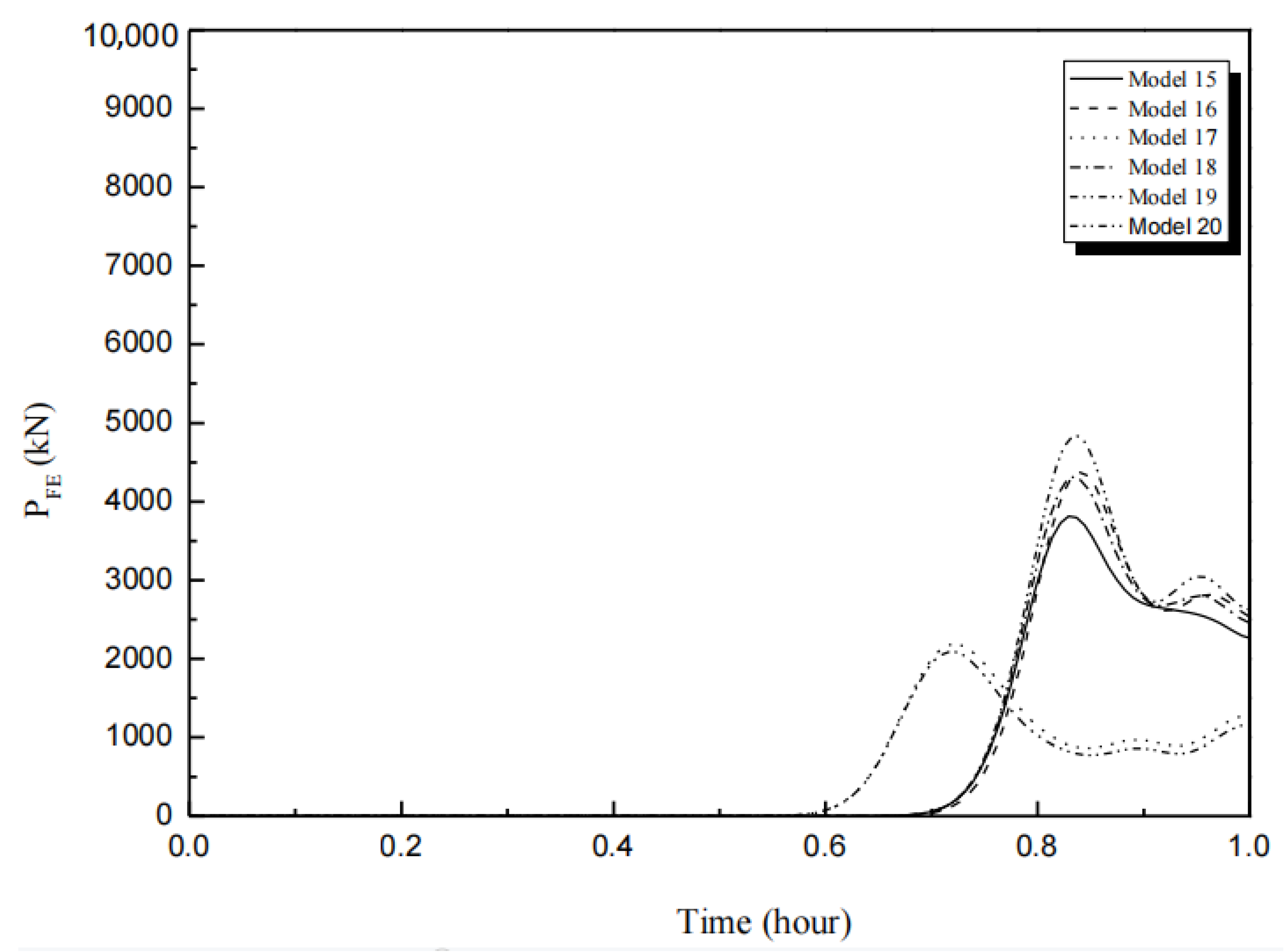

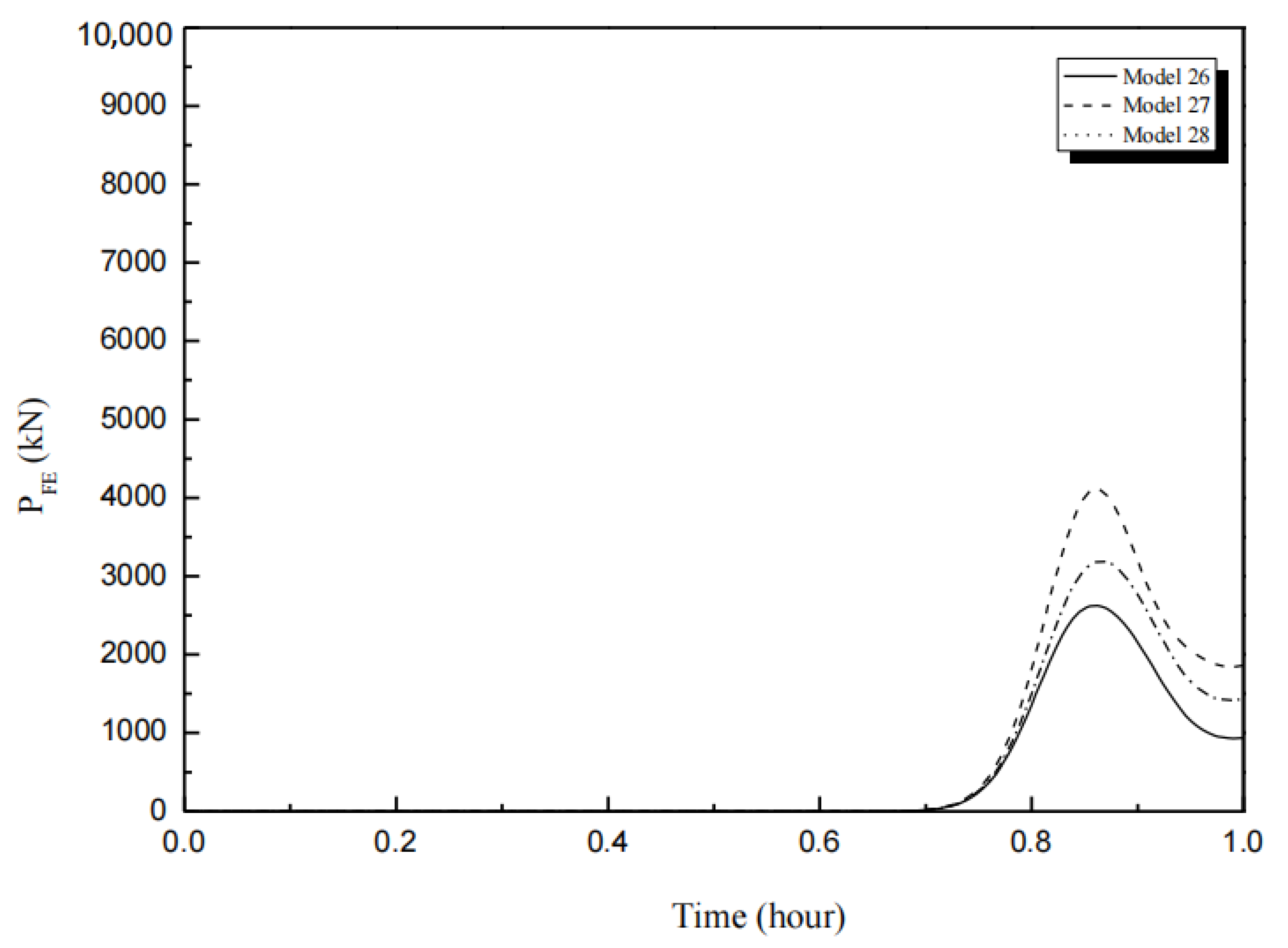
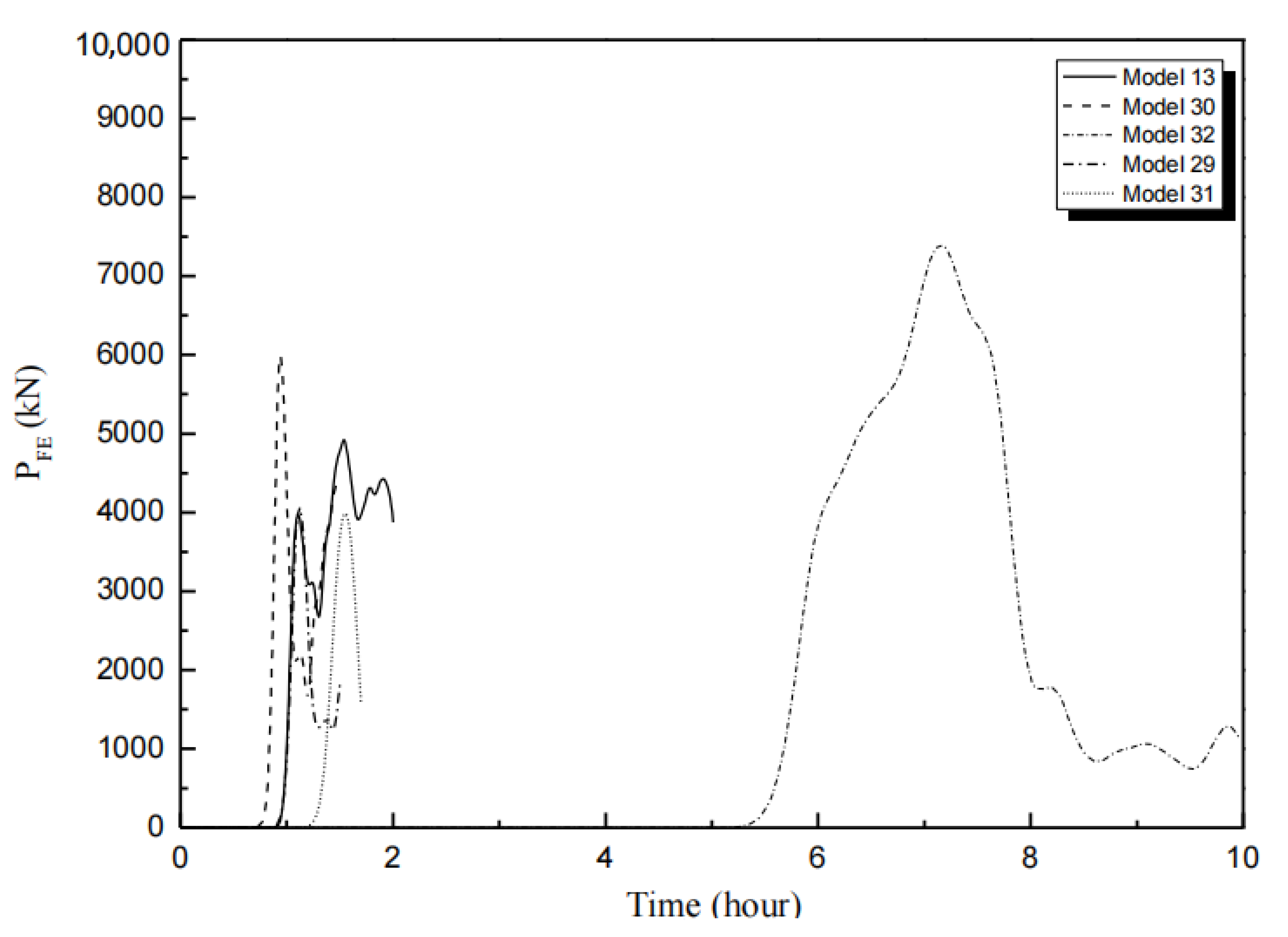
| Technique | Input | Output | Description | Reference |
|---|---|---|---|---|
| GEP | D, t, fy, fc, L, tf,ff, Ef | P | 92 FRP-CFST columns | [39] |
| ANN | D, t, fy, fc, L | P | 633 CCFST columns | [40] |
| GEP | D, t, fy, fc, L | P | 314 CCFST columns | [21] |
| ANN | D, t, fy, fc, L | P | 272 CCFST columns | [33] |
| ANN | D, t, fy, fc, L | P | 205 CFST columns | [42] |
| SVM | B, t, fy, fc, L, Ec, Es | P | 180 SCFST columns | [34] |
| ANFIS-GA; ANFIS-PSO | D, t, tp, fy, fc, L | P | 57 steel Y-section columns | [35] |
| ANN | fc, L, D, tf, Ef, εfu, εcc | P | 465 FRP-CCFST columns | [36] |
| GP | fc, L, D, tf, Ef | P | 832 FRP-CCFST columns | [37] |
| No. | Pexp (kN) | PFE (kN) | Error (FE) (%) |
|---|---|---|---|
| 1 | 2866 | 3171 | 11 |
| 2 | 2314 | 2640 | 14 |
| 3 | 7837 | 7919 | 1 |
| 4 | 9085 | 7928 | 13 |
| 5 | 9187 | 7994 | 13 |
| 6 | 6915 | 7946 | 15 |
| 7 | 7407 | 8032 | 8 |
| 8 | 6838 | 7791 | 14 |
| 9 | 7569 | 7890 | 4 |
| 10 | 1771 | 1554 | 12 |
| 11 | 3339 | 3037 | 9 |
| 12 | 3501 | 3050 | 13 |
| 13 | 4837 | 4320 | 11 |
| 14 | 4216 | 3850 | 9 |
| 15 | 4330 | 3812 | 12 |
| 16 | 4751 | 4313 | 9 |
| 17 | 4930 | 4379 | 11 |
| 18 | 5254 | 4738 | 10 |
| 19 | 2160 | 2184 | 1 |
| 20 | 2250 | 2092 | 7 |
| 21 | 1242.2 | 1100 | 11 |
| 22 | 1425.3 | 1225 | 14 |
| 23 | 1637.9 | 1432 | 13 |
| 24 | 1943.4 | 1672 | 14 |
| 25 | 2866 | 3088 | 8 |
| 26 | 2550 | 2642 | 4 |
| 27 | 3150 | 3195 | 1 |
| 28 | 3400 | 3926 | 15 |
| 29 | 3850 | 4073 | 6 |
| 30 | 5400 | 5993 | 11 |
| 31 | 3338 | 3854 | 15 |
| 32 | 8648 | 7694 | 11 |
| No. | Pexp (kN) | PFE (kN) | PGEP (kN) | Error (FE) (%) | Error (GEP) (%) |
|---|---|---|---|---|---|
| 1 | 2866 | 3171 | 3151.69 | 11 | 9.9 |
| 2 | 2314 | 2640 | 2113.89 | 14 | 8.6 |
| 3 | 7837 | 7919 | 6894.05 | 1 | 12.0 |
| 4 | 9085 | 7928 | 8798.49 | 13 | 3.2 |
| 5 | 9187 | 7994 | 8929.05 | 13 | 2.8 |
| 6 | 6915 | 7946 | 6637.38 | 15 | 4.0 |
| 7 | 7407 | 8032 | 6849.84 | 8 | 7.5 |
| 8 | 6838 | 7791 | 6391.7 | 14 | 6.5 |
| 9 | 7529 | 7890 | 6834.93 | 4 | 9.7 |
| 10 | 1771 | 1554 | 1815.07 | 12 | 2.5 |
| 11 | 3339 | 3037 | 3086.68 | 9 | 7.6 |
| 12 | 3501 | 3050 | 3331.11 | 13 | 4.9 |
| 13 | 4837 | 4320 | 4438.7 | 11 | 8.2 |
| 14 | 4216 | 3850 | 4098.37 | 9 | 2.8 |
| 15 | 4330 | 3812 | 4549.91 | 12 | 5.1 |
| 16 | 4751 | 4313 | 4587.73 | 9 | 3.4 |
| 17 | 4930 | 4379 | 4808.45 | 11 | 2.5 |
| 18 | 5254 | 4738 | 5756.6 | 10 | 9.6 |
| 19 | 2160 | 2184 | 2160.52 | 1 | 0.0 |
| 20 | 2250 | 2092 | 2143.02 | 7 | 4.8 |
| 21 | 1242.2 | 1100 | 1242.01 | 11 | 0.0 |
| 22 | 1425.3 | 1225 | 1625.42 | 14 | 14 |
| 23 | 1637.9 | 1432 | 2022.22 | 13 | 23 |
| 24 | 1943.4 | 1672 | 2213.29 | 14 | 13.9 |
| 25 | 2866 | 3088 | 3077.52 | 8 | 7.4 |
| 26 | 2550 | 2642 | 2465.14 | 4 | 3.3 |
| 27 | 3150 | 3195 | 2852.55 | 1 | 9.4 |
| 28 | 3400 | 3926 | 3031.56 | 15 | 10.8 |
| 29 | 3850 | 4073 | 3672.81 | 6 | 4.6 |
| 30 | 5400 | 5993 | 4703.31 | 11 | 12.9 |
| 31 | 3338 | 3854 | 3569.71 | 15 | 6.9 |
| 32 | 8648 | 7694 | 8870 | 11 | 2.6 |
Publisher’s Note: MDPI stays neutral with regard to jurisdictional claims in published maps and institutional affiliations. |
© 2021 by the authors. Licensee MDPI, Basel, Switzerland. This article is an open access article distributed under the terms and conditions of the Creative Commons Attribution (CC BY) license (https://creativecommons.org/licenses/by/4.0/).
Share and Cite
Jiang, H.; Mohammed, A.S.; Kazeroon, R.A.; Sarir, P. Use of the Gene-Expression Programming Equation and FEM for the High-Strength CFST Columns. Appl. Sci. 2021, 11, 10468. https://doi.org/10.3390/app112110468
Jiang H, Mohammed AS, Kazeroon RA, Sarir P. Use of the Gene-Expression Programming Equation and FEM for the High-Strength CFST Columns. Applied Sciences. 2021; 11(21):10468. https://doi.org/10.3390/app112110468
Chicago/Turabian StyleJiang, Huanjun, Ahmed Salih Mohammed, Reza Andasht Kazeroon, and Payam Sarir. 2021. "Use of the Gene-Expression Programming Equation and FEM for the High-Strength CFST Columns" Applied Sciences 11, no. 21: 10468. https://doi.org/10.3390/app112110468
APA StyleJiang, H., Mohammed, A. S., Kazeroon, R. A., & Sarir, P. (2021). Use of the Gene-Expression Programming Equation and FEM for the High-Strength CFST Columns. Applied Sciences, 11(21), 10468. https://doi.org/10.3390/app112110468







